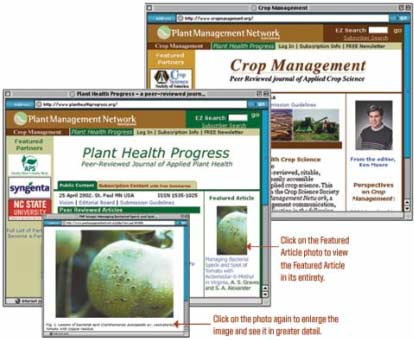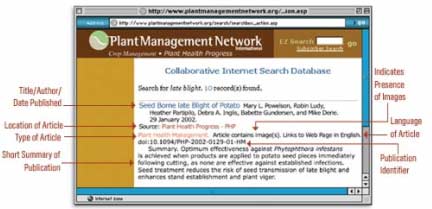February 2003 // Volume 41 // Number 1 // Tools of the Trade // 1TOT2
The Plant Management Network: A New Online Source of Applied Plant Science Information
Abstract
The Plant Management Network (PMN) is
a new online, multi-disciplinary, plant science
network of peer-reviewed journals and applied plant
information serving as an important resource for
Extension professionals and their audiences. PMN
is designed to extend Extension research and information
out to growers, advisors, and the Extension community.
In addition to the journals, partner publications,
and image gallery--presently searchable on the site--new
features are being prototyped, including scripted
PowerPoint presentations, online posters, and continuing
education modules. Articles are published on PMN
within 1-3 weeks of acceptance, without charge.
Individuals and partner organizations support the
PMN through annual subscriptions.
Introduction
In the mid-1990's an informal, diverse group of plant scientists discussed the potential for an online journal of applied plant science. This journal would incorporate all the plant science disciplines and cover subjects ranging from cultivar selection to fertilizer trials to plant problem solutions. It would be open to applied plant science research on all commodities. Rosarians, corn and soybean growers and consultants, turf specialists, foresters, and everyone in-between could publish their applied research online and use the digital environment to search for needed information. This information would be peer-reviewed and published in real-time on the Internet, making it immediately available globally.
In June 2000, the interdisciplinary journal, Plant Health Progress, was launched and has today evolved into the Plant Management Network (PMN) <http://www.plantmanagementnetwork.org/>, serving the broad needs of extension and plant practitioners worldwide (Figure 1).
Figure 1.
Plant Management Network Home Page

What Is the Plant Management Network?
In 2 short years, the online, applied, plant science journal concept has evolved into an Internet resource serving Extension faculty with their land-grant mission while providing valuable applied information for consultants, crop advisors, growers, and industry. Essentially, there are two major categories of content provided by the Network, peer-reviewed journals and an index of plant-related resources, including Extension publications and images.
Currently, there are two journals being published, with a third journal expected to be launched in 2003. The first journal, sponsored by the American Phytopathological Society and titled Plant Health Progress, was launched in June of 2000 to cover all types of plant problems, and it includes five peer-reviewed categories in which to publish:
- Plant Health Research,
- Diagnostic Guides,
- Plant Health Management,
- Plant Health Reviews, and
- Plant Health Briefs (Figure 2).
Detailed descriptions of the style and content of each of these categories is given on the Web site. A section for industry news, perspectives, and editorial comments is standard in each of the PMN journals.
Figure 2.
Plant Health Briefs with Full-Color Pictures

In February 2002, the second PMN journal, Crop Management <http://www.cropmanagement.org/>, was launched with support from the Crop Science Society of America. It also contains several categories in which to publish:
- Crop Management Research,
- Crop Management Reviews,
- Crop Management Guides, and
- Crop Management Briefs.
Both of these and future journals provide a place for Extension staff at the state, regional, and county level to publish their applied research, making it available for all and easily retrievable in the future. This type of information is currently either not published, sometimes published in station bulletins, or presented at winter meetings and then often forgotten. Through PMN, authors, including Extension faculty and staff, can receive peer-reviewed credit for their work while making detailed information readily available through PMN search features.
Benefits for Authors
The benefits of publishing in PMN journals go beyond supporting a place for the collection of peer-reviewed, applied plant science information across disciplines. There are no page charges, and authors are encouraged to use color images and graphics (Figure 3). Information is published quickly and broadly, and authors receive a .pdf file of their article that they can place on their personal Web site as well as send to others interested in their paper.
Figure 3.
Examples of the Online PMN Journals

Articles in both journals are posted within 1-3 weeks of finishing peer-review, and manuscripts are fully citable and archived for ready access. Articles posted in PMN journals are published first in the public area of the site, where they are freely available to all, and then moved into the PMN archives as newer information is published. Subscriber status is necessary to view papers within the archives; however, all articles always have a brief summary with article title, authors, and one or more color images available permanently in the public portion of the site.
Other Features of PMN
All Network journals are indexed in both a public search and a more refined, subscriber-only search tool (Figure 4). Partners have added their pertinent Extension publications to the index, making the Network a ready resource of current, science-based information on numerous topics from raspberries to trees to rice. An image resource of more than 1,500 images was added to PMN in November 2002 and is building. Future resources such as scripted PowerPoint presentations, posters from scientific meetings, and continuing education (CEU's) modules for personal study or professional certification purposes are currently being prototyped.
Figure 4.
PMN Search Tool

Who Pays for the PMN?
The PMN is financially supported by partners, individual subscribers, and library subscriptions. Partners are able to help guide the development of the Network and index any or all of their Extension and other publications within the Network's searchable database. They also have their logo, a 100-word description, and contact information, including links, displayed on the PMN site. Faculty, students, and staff of university partners have subscriber access to the complete PMN site from their personal computers.
Summary
The Plant Management Network is an important online-only resource that strongly supports the plant science Extension community and their programs. It provides a single Internet venue for publishing applied research and finding and sharing plant and agricultural related, science-based information.
PMN Direct Site Links
The Plant Management Network <http://www.plantmanagementnetwork.org/>
Crop Management <http://www.cropmanagement.org/>
Plant Health Progress <http://www.planthealthprogress.org/>
PMN Partners <http://www.plantmanagementnetwork.org/partners/profile/>
PMN Partners Program <http://www.plantmanagementnetwork.org/partners/join.asp>
PMN Subscription Info <http://www.plantmanagementnetwork.org/about/subscribe/>
PMN Contact <editorialoffice@plantmanagementnetwork.org>
